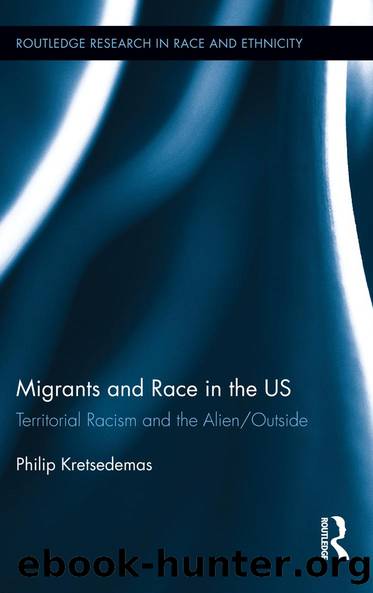Migrants and Race in the US by Philip Kretsedemas

Author:Philip Kretsedemas [Kretsedemas, Philip]
Language: eng
Format: epub
ISBN: 9781138957473
Google: j4NIjgEACAAJ
Publisher: Routledge
Published: 2015-01-15T04:52:39+00:00
Deportation and Labor Control
Another consideration that should be factored into the expansion of the deportation caseload is the workplace power struggle. This isnât the same thing as labor-flow regulation, which leads deportation rates to fluctuate in response to boom and bust periods of employment for migrant workers (as in Hansonâs âshock-absorberâ thesis). Itâs also not the same thing as an attrition-enforcement agenda that aims to reduce the entire unauthorized migrant population, or a policing model that targets noncitizens with criminal violations.
In this case, the aim is to control specific individuals or groups of workers who are challenging the structure of authority in the workplace. Workers may have the legal right to raise these challenges, but unauthorized migrants jeopardize their residency in the US by doing so. Labor researchers have shown that there is a history of employers calling immigration enforcement on workers while they are attempting to unionize or are in the middle of contract negotiations.56 Employers have also called immigration enforcement on their workers to avoid legal culpability for workplace injuries. This is what happened to Edgar Velazquez, who sliced open his face while operating a chain saw under the employment of a landscaping company.57 Velazquez, who is an unauthorized migrant, tried to file a personal-injury claim but was deported before his case went before the local courts.
Velazquezâs deportation hypothetically could have been averted by the deferred-action program that the Obama administration implemented in 2012 (he was deported in 2007). Velazquez was twenty years old when he was injured and had no criminal record. But his story sheds light on the situation of unauthorized migrantsâyoung and oldâwho have no plans (or sufficient resources) to pursue a college education and who spend their adult lives working in hazardous, low-wage employment sectors. Velazquezâs story also sheds light on a kind of expendability that has become a part of the organizational structure of these employment sectors. It so happens that Velazquez was injured during a period of time when the rate of Latino workplace deaths and injuries was significantly higher than the national average.58 There is also a relationship between the growth and decline of these Latino/non-Latino injury-rate correlations and the growth and decline of the unauthorized migrant workforce.59
The Velazquez case is unusual in many ways. Unauthorized migrant workers do not routinely take their employers to court, employers do not usually call immigration enforcement on their employees and unauthorized migrant workers who get caught up in these struggles donât usually get the outpouring of public support that Velazquez received.60 But the fact that deportable workers are concentrated in jobs with high incidents of workplace injuries and fatalities is not unusual at all. When viewed in light of these broader trends, the Velazquez story draws attention to the way that expendability can be used to control the behavior of specific workers.
The potential to be deported can influence day-to-day inter-personal relationships between employers and employees in informalized work spaces. This relationship is defined by a reciprocal exchange between the âgood behaviorâ of the employee and the employerâs willingness to protect the employee from the law.
Download
This site does not store any files on its server. We only index and link to content provided by other sites. Please contact the content providers to delete copyright contents if any and email us, we'll remove relevant links or contents immediately.
| Anthropology | Archaeology |
| Philosophy | Politics & Government |
| Social Sciences | Sociology |
| Women's Studies |
Nudge - Improving Decisions about Health, Wealth, and Happiness by Thaler Sunstein(7255)
iGen by Jean M. Twenge(5166)
The Fire Next Time by James Baldwin(5024)
Adulting by Kelly Williams Brown(4239)
The Hacking of the American Mind by Robert H. Lustig(4092)
The Sports Rules Book by Human Kinetics(4079)
The Ethical Slut by Janet W. Hardy(4042)
Captivate by Vanessa Van Edwards(3732)
Mummy Knew by Lisa James(3522)
In a Sunburned Country by Bill Bryson(3374)
The Worm at the Core by Sheldon Solomon(3327)
Ants Among Elephants by Sujatha Gidla(3282)
Suicide: A Study in Sociology by Emile Durkheim(2908)
The Slow Fix: Solve Problems, Work Smarter, and Live Better In a World Addicted to Speed by Carl Honore(2843)
The 48 laws of power by Robert Greene & Joost Elffers(2816)
Humans of New York by Brandon Stanton(2690)
Handbook of Forensic Sociology and Psychology by Stephen J. Morewitz & Mark L. Goldstein(2605)
The Happy Hooker by Xaviera Hollander(2586)
The Tipping Point by Malcolm Gladwell(2563)
